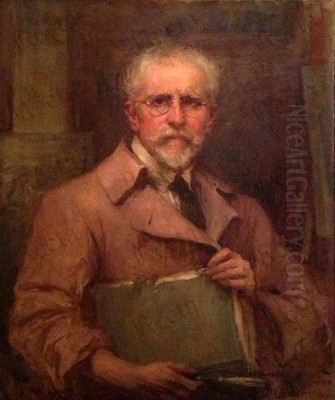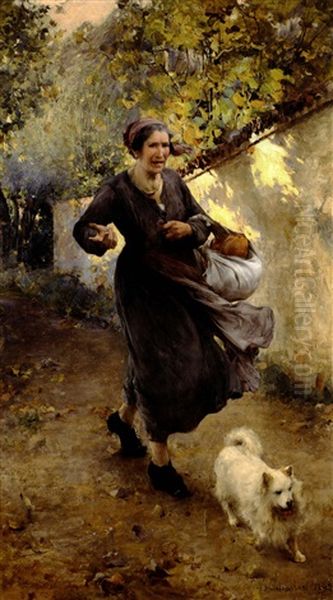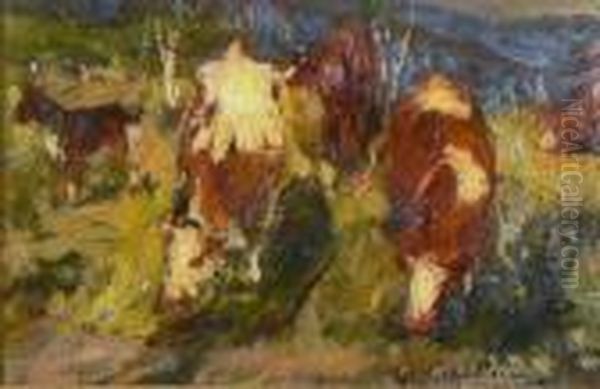
Vittorio Cavalleri (1860-1938) stands as a significant figure in Italian art during the late nineteenth and early twentieth centuries. Born in Turin, the vibrant capital of the Piedmont region, Cavalleri dedicated his life to capturing the nuances of the world around him through painting. His artistic journey began formally at the prestigious Accademia Albertina in Turin, an institution that nurtured many talents and shaped the artistic landscape of Northern Italy. It was here that he honed the skills that would define his long and productive career.
Cavalleri emerged onto the public art scene relatively early. His debut at the important Esposizione Generale Italiana di Torino (Italian General Exhibition of Turin) in 1884 marked the beginning of decades of active participation in the artistic life of Italy and beyond. This initial exposure set the stage for a career characterized by consistent production and exhibition, establishing him as a reliable and respected presence in the Italian art world.
Artistic Focus and Dominant Themes
Cavalleri's oeuvre is diverse, encompassing landscape painting, portraiture, genre scenes, and still life. However, he developed particular renown for his sensitive depictions of landscapes, especially those capturing the distinct beauty of his native Piedmont. His works often convey a deep affection for the rural countryside, its inhabitants, and their daily lives. He possessed a keen eye for the interplay of light and shadow, rendering scenes with a delicate realism that resonated with audiences.
A recurring and beloved theme in Cavalleri's work is the world of childhood. He frequently painted children, often focusing on their games and toys. These works are imbued with a sense of joy and innocence. Notably, some of these compositions were inspired by the verses of the poet and composer Arrigo Boito, suggesting a thoughtful engagement with contemporary culture and a desire to translate poetic sentiment into visual form. These paintings celebrate the simple pleasures and imaginative world of youth.

Beyond children, Cavalleri masterfully depicted scenes of everyday rural life. He captured the rhythms of the countryside, the activities of its people, and the atmosphere of villages and farms. His paintings often feature figures engaged in simple tasks, set against meticulously rendered natural or architectural backgrounds. This focus aligns him with a broader European trend of depicting peasant life and regional character, but Cavalleri brought his own distinct sensitivity and observational skill to the subject.
Stylistic Approach: Realism and Romanticism
Stylistically, Cavalleri navigated the currents of late nineteenth-century art, blending elements of Realism with a distinct Romantic sensibility. His commitment to careful observation, detailed rendering, and accurate depiction of light places him firmly within the realist tradition that dominated much of European painting during his formative years. He sought to capture the tangible reality of his subjects, whether a sun-dappled landscape, the texture of fabric, or the expression on a face.
However, his work often transcends mere objective representation. A palpable sense of atmosphere, mood, and sometimes nostalgia infuses his paintings, revealing a romantic inclination. His landscapes are not just topographical records but evoke feelings associated with place and time. His genre scenes, particularly those involving children or rural life, often carry a gentle, poetic quality. This blend allowed him to create works that were both grounded in reality and emotionally resonant.
His handling of light and color was particularly noted by contemporaries. He demonstrated a sophisticated understanding of how light affects surfaces and defines form. His palette could range from subtle and harmonious in landscape passages to vibrant and lively in depictions of figures or still lifes. This technical proficiency underpinned the appeal and success of his work throughout his career.
Notable Works and Recognition
Throughout his career, Vittorio Cavalleri produced a substantial body of work, with several paintings gaining particular recognition. His painting Per via (On the Road, or Through the Street), created in 1892, is a significant example of his large-scale genre work (measuring 255 x 145.5 cm). While it reportedly received some criticism, it was generally praised by the public and critics for its sensitive capture of light, color, and the nuances of daily life, showcasing his ambition and technical skill early in his mature career.
Another key work highlighting his interest in rural themes is La fontana del Melograno (The Pomegranate Fountain), painted in 1894. This piece likely exemplifies his ability to combine landscape, architecture, and human presence into a cohesive and evocative scene, typical of his engagement with the Piedmontese environment.

His versatility is further demonstrated in works like Testa di Cristo (Head of Christ) from 1899. This oil painting (67 x 43 cm) indicates his willingness to engage with religious subjects, a common practice for artists of the period, allowing him to explore different emotional registers and iconographic traditions.
Genre scenes depicting domestic interiors and activities were also part of his repertoire, as seen in Donna che cuce alla finestra (Woman Sewing by the Window). This work (71 x 91.5 cm) likely showcases his skill in rendering interior light and capturing quiet, intimate moments, a contrast to his expansive landscapes.
His love for nature is evident in smaller, perhaps more personal works like Il pergolato fiorito (The Flowering Pergola). Measuring just 28 x 40 cm, such paintings demonstrate his consistent attention to the beauty of the natural world, capturing the vibrancy of flowers and foliage with his characteristic sensitivity to light and color.
Exhibition History and Professional Engagement
Cavalleri was a highly active participant in the major art exhibitions of his time, both within Italy and internationally. His regular presence at these events was crucial for building his reputation and securing patronage. Following his 1884 debut in Turin, he became a fixture at the city's key art venues.
He frequently exhibited at the annual shows organized by the Società Promotrice delle Belle Arti (Society for the Promotion of Fine Arts) and the Circolo degli Artisti (Artists' Circle) in Turin. His participation in the Quadriennale Torinese (Turin Quadrennial) in 1902 and 1906 further cemented his status within the regional art establishment. These Turin-based exhibitions were vital platforms for Piedmontese artists.
Crucially, Cavalleri gained wider recognition through his consistent participation in the Venice Biennale. From approximately 1895 to 1910, he was a frequent exhibitor at this prestigious international event, which rapidly became one of the most important showcases for contemporary art globally. His repeated inclusion and the fact that he received multiple awards there underscore the quality and appeal of his work on a national and international level. He also participated in the Paris Salon, the epicenter of the art world for much of the nineteenth century, exposing his work to a discerning French audience.
Interest in Medieval Art and Miniatures
Beyond his primary practice as a painter, Cavalleri nurtured a keen interest in medieval art, demonstrating a scholarly and appreciative eye for historical aesthetics. He was particularly drawn to the intricate art of the miniature. This passion was not merely a private hobby; it informed his broader artistic understanding and occasionally surfaced in his professional activities.
A notable instance of this interest was his contribution to the 1884 Turin National Exhibition, the same event where he made his public debut as a painter. He designed exhibition panels for this major exposition, and these designs reportedly showcased his deep understanding and appreciation of medieval artistic forms and motifs. This suggests an artist with a broad historical consciousness, capable of engaging with different eras and styles.
This fascination with the medieval period might also subtly inform the romantic or poetic qualities sometimes found in his paintings. An appreciation for the craftsmanship, symbolism, and narrative richness of medieval art could easily translate into a heightened sensitivity to mood and detail in his own contemporary work. It points to an artist grounded in his own time but also connected to the long lineage of Italian artistic heritage.
Contemporaries and Artistic Milieu
Vittorio Cavalleri worked during a dynamic period in Italian art, bridging the traditions of the nineteenth century with the emerging currents of the twentieth. He was part of a vibrant artistic community, particularly in Turin, which was a significant cultural center alongside Milan, Florence, and Rome. His contemporaries included a wide range of artists exploring different styles and subjects.
In the realm of landscape painting, particularly focused on the Piedmont region, he shared the stage with artists like Lorenzo Delleani, another prominent painter known for his depictions of the Alpine foothills. While their styles differed, they both contributed significantly to the visual identity of Piedmontese art. Cavalleri also taught, and one of his students, Luigi Lupo, specialized in Alpine landscapes, particularly those of the Val d'Aosta, creating a direct lineage and perhaps friendly competition in similar subject matter.
On the broader Italian stage, Cavalleri's career overlapped with major figures associated with various movements. The late Macchiaioli, such as Telemaco Signorini, were still influential. The Divisionists, like Giovanni Segantini and Giuseppe Pellizza da Volpedo, were exploring new ways to depict light and social themes, often with Alpine or rural settings that might offer points of comparison or contrast with Cavalleri's work.
In the context of international exhibitions like the Venice Biennale or the Paris Salon, Cavalleri's works would have been shown alongside those of celebrated Italian artists like Giovanni Boldini or Antonio Mancini, as well as leading artists from across Europe. This placed him within a competitive but stimulating international environment.
The provided information also mentions market competition with artists like Cino Bozzetti, whose work Pascolo (Pasture, 1876) was comparable in estimate to a landscape by Cavalleri. Other names from the period mentioned in related contexts include Paolo Borroni, Valore Casini, Giuseppe Guzzardi, Silvio Allori, and the sculptor Giuseppe Grandi, illustrating the diverse artistic production of the era. Although direct collaborative or rivalrous relationships are not detailed in the source material, Cavalleri undoubtedly navigated this complex network of artists through exhibitions, societies, and the art market.
His connection with the poet Arrigo Boito places him in contact with the broader cultural world, while the mention of Vittorio Alfieri, a major figure of Italian literature (though from an earlier era, his cultural influence persisted), suggests the intellectual currents Cavalleri might have engaged with, possibly absorbing influences indirectly, such as the French cultural leanings associated with Alfieri.
Furthermore, while Cavalleri largely remained committed to representational painting, his career coincided with the rise of Italian Futurism. Although his style was distinct, the mention of an experiment involving depicting a "rotating onion" as an exploration of dynamic movement hints at an awareness of, or perhaps an independent arrival at, concerns about representing motion that would become central to artists like Giacomo Balla and Umberto Boccioni shortly thereafter.
Technique and Potential Cross-Cultural Elements
Cavalleri's technical approach was characterized by solid academic training combined with personal stylistic choices. His mastery of oil painting is evident in the works listed, showcasing his ability to handle texture, form, and color effectively. His use of light and shadow, sometimes described as employing chiaroscuro techniques reminiscent of Symbolist painters, was a key element in creating depth and atmosphere in his compositions. This suggests an awareness of contemporary stylistic trends beyond pure Realism.
His method could also involve layering colors, building up surfaces from broader areas of tone towards brighter highlights or points of detail. This technique, mentioned in relation to making figures appear vivid, speaks to a deliberate and controlled application of paint to achieve specific visual effects, enhancing the sense of life and presence in his subjects.
The provided information hints at potential cross-cultural elements, although specifics remain somewhat elusive. An influence from "Eastern art," potentially linked to China, is mentioned, though without elaboration. This could refer to compositional strategies, decorative motifs, or a general aesthetic sensibility, reflecting the broader European interest in Japonisme and Chinoiserie during the late 19th and early 20th centuries.
His study of Italian Renaissance art, such as the frescoes at the Castello di Issogne, also represents a form of cultural engagement across time. Renaissance art itself often contained elements absorbed from classical antiquity or through trade routes, potentially embedding layers of historical cross-cultural exchange within the very tradition Cavalleri studied. The indirect connection to French culture via Vittorio Alfieri might also be considered a subtle cross-cultural thread.
Legacy and Conclusion
Vittorio Cavalleri passed away in 1938, leaving behind a significant legacy as a painter who skillfully captured the essence of his time and place. He remained largely faithful to the representational traditions he inherited, yet infused his work with a personal sensitivity to light, atmosphere, and human experience. His dedication to depicting the landscapes and life of Piedmont makes him a key figure in the region's art history.
His success at major national and international exhibitions, including the Venice Biennale, attests to the widespread appeal of his art during his lifetime. He navigated the transition from the nineteenth to the twentieth century, maintaining a consistent artistic vision while showing subtle awareness of contemporary developments. His paintings of children, rural scenes, and landscapes continue to be appreciated for their technical skill, charm, and evocative power.
While the provided sources do not indicate any major controversies or particularly unusual anecdotes surrounding his life, they paint a picture of a dedicated, respected, and successful professional artist. He contributed significantly to the Italian art scene through his paintings, his participation in exhibitions, and his engagement with both contemporary culture and historical art forms. Vittorio Cavalleri remains an important representative of Italian Realism and Romanticism, a painter whose works offer a luminous window onto the world of late nineteenth and early twentieth-century Italy.